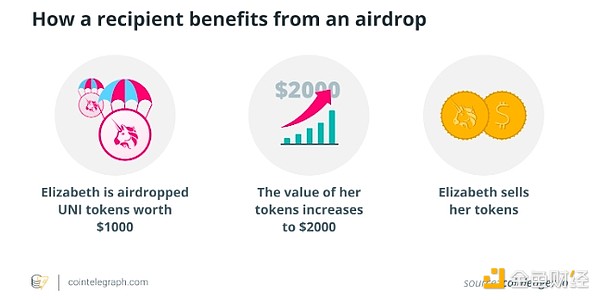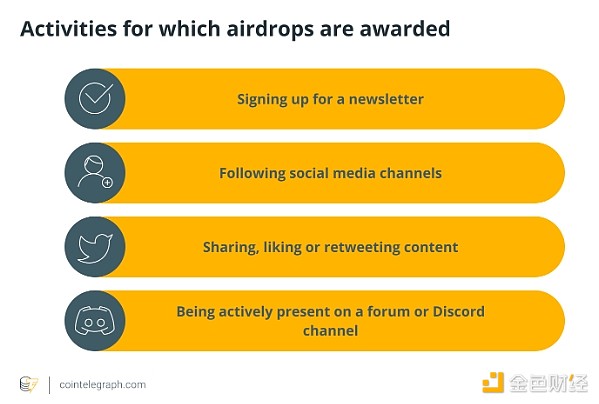Author: James Smith, CoinTelegraph; Compiler: Baishui, Golden Finance
Summary
Cryptocurrency airdrops are like surprise gifts where users receive free tokens. New blockchain projects often give them away to promote their tokens, similar to free samples in a store.
To participate in an airdrop, users may need to follow the project on social media or join their community. The project team decides the rules, and the tokens are usually automatically allocated directly to the user's wallet using smart contracts.
There are different types of airdrops. Standard airdrops require a wallet address, bounty airdrops involve completing tasks, and holder airdrops reward existing token holders.
Participants should avoid scams by researching the project, being wary of phishing attempts, not sharing private keys, and using a secure wallet.
Airdrops are often considered a "free lunch" in the crypto world, designed to spark interest in and raise awareness of upcoming projects. Think of them as a surprise gift from a new restaurant in town – a way to spread the word about their delicious food.
In the crypto world, airdrops work the same way. A new blockchain project wants people to know about it, so they “drop” free tokens into the digital wallets of potential users. Sometimes all you need to do is hold a particular token or register with interest, and voila! You get some cryptocurrency in your wallet, just like a free food sample. It’s a simple and effective way to introduce you to their “style” and encourage you to get more involved in their project.
This guide will explain how cryptocurrency airdrops work, the different types available, how to claim them, and most importantly how to participate safely and avoid potential scams.
What are cryptocurrency airdrops?
Airdrops are the cryptocurrency equivalent of surprise gifts. Imagine opening a box and discovering coins inside! This is similar to receiving an announcement about free tokens or coins from a new blockchain project. Crypto airdrops involve distributing digital assets into users’ wallets for free, or in exchange for completing simple tasks, such as following a project on social media or joining their online community.
In the crypto ecosystem, airdrops play a vital role. New projects use airdrops as a marketing strategy to increase awareness and build a user base. They are like free samples in a supermarket, enticing users to try new products.
From a user's perspective, airdrops offer an opportunity to get new cryptocurrencies with minimal effort and the potential for huge gains. These tokens are more than just freebies, they are a way to participate in the growing digital economy.
How do cryptocurrency airdrops work?
Crypto airdrops usually start with a project sending free tokens to your wallet address as part of its marketing strategy. While the project team determines the eligibility criteria for the airdrop and how it is specifically executed, here is a general overview of how cryptocurrency airdrops work:
Announcements: The project team posts information about upcoming airdrop events and participation requirements on the website, social media, and forums. The team collects wallet addresses from applicants.
Eligibility:Users may need to meet specific requirements to be eligible for an airdrop. These requirements may include following the project on social media, sharing content, signing up for a Telegram group, or having a minimum amount of another cryptocurrency in their wallet.
Snapshots:The project takes a snapshot of the blockchain at a predetermined time and date to identify eligible wallet addresses. This helps determine who meets the eligibility criteria.
Distribution:The project uses smart contracts to send tokens directly to the wallet addresses of record. Distribution is usually automatic and free. Projects usually use their treasury wallets to send airdrops and make the transaction blocks public to prove that the distribution of tokens is unbiased.
Receiving Tokens:Tokens are usually sent to the wallet address of the airdrop recipient without them having to claim the tokens.
Use:Once users receive the tokens, they can hold, trade, or use the tokens to contribute to the project's ecosystem and add value.

Types of Crypto Airdrops
Projects can choose from a number of types of crypto airdrops:
Standard Airdrops:In a standard crypto airdrop, users only need to provide a wallet address to receive free tokens. There is usually a cap on the number of tokens each participant can receive. Standard airdrops are time-sensitive and popular because they are easy to join. Some people create multiple wallets to get more tokens, thereby gaining an advantage over others who use a single wallet address.
Bounty Airdrops:Users must meet specific requirements, such as tweeting about the program or sharing on other social media, to be included in the list of participants. Incentives may include referring others, subscribing to a newsletter, or joining a Discord channel. Completing these tasks earns users points, which determine the size of the airdrop. For example, a user may need to earn 500 points to qualify for an airdrop.

Holder Airdrops:Holders of specific cryptocurrency tokens can automatically receive free tokens in holder airdrops. The number of free tokens depends on how many tokens the user already holds. The blockchain's public ledger makes it easy to see who owns a specific token. However, some people who hold tokens may not want an airdrop. Sometimes, eligibility may be limited to a specific number of tokens, or the number of tokens may determine the total reward.
Exclusive Airdrops:Exclusive airdrops are given to selected individuals. Criteria may include time dedicated to the project, money spent on products other than tokens, or participation in forums. Projects often reward active participants regardless of whether they own tokens.
Raffle Airdrops:Raffle airdrops combine various airdrop types. Projects offering raffle airdrops will inform participants of the number of airdrops they will distribute and ask anyone interested to obtain a raffle ticket (a lottery-style system). Users can obtain tickets by holding tokens or earning points. Sometimes, simply expressing interest is enough to qualify. Often, the number of people seeking airdropped tokens exceeds the project's intention to distribute them. In this case, the airdrop will be sent to a limited number of randomly selected wallets.
Benefits to Projects
Expand User Base:Airdrops bring projects to a wider audience, thereby acquiring more users.
Awareness of Projects:Airdrops send free tokens to users, incentivizing them to spread the word about the project.
Build Community:Airdrops can encourage user participation and create a sense of community around a project.
Benefits to Recipients
Free Crypto:You can earn free tokens through airdrops, which may increase in value over time.
Learning Opportunities:Participating in airdrops can provide information about valuable upcoming projects.
Early Access:Airdrops can give users early access to a project.
Risks and Challenges of Cryptocurrency Airdrops
While beneficial, airdrops also present certain risks and challenges:
For Projects
Attracting Non-Committed Users:Some participants may only be interested in free tokens, not the project itself.
Sybil Attacks:Malicious actors may create multiple accounts to claim more tokens than intended, undermining a fair distribution.
Regulatory Uncertainty:The legal status of airdrops varies by jurisdiction, which can lead to compliance challenges.
For Recipients
Scams and Fraud:Fake airdrops may result in financial losses or personal information leaks.
Dust Attacks:A small amount of tokens sent to a wallet can be used to track a user's transaction history.
Tax Implications:Depending on local regulations, receiving airdropped tokens may trigger tax obligations.
Security Risks:Downloading malware or interacting with phishing links related to airdrops may compromise device security.
How to Avoid Airdrop Scams?
Scams have damaged the reputation of airdrops, and participants need to know how to avoid airdrop scams. Here's how to avoid airdrop scams:
Do your research:Before participating in an airdrop, research the project and the team behind it. Look for reviews from other users and check if the project has been audited by a reputable security company.
Beware of phishing scams:Phishing scams are designed to trick users into revealing their personal information or private keys. Be careful of any links or emails you receive about airdrops, and never click on links shared by unknown sources.
Say no to unsolicited offers:Projects often announce airdrops on their websites or social media channels. Be skeptical of any airdrop you haven't heard of before or that seems too good to be true.
Never share your private keys:Never share your private keys. Never share them with anyone, even if they claim to be from a legitimate project.
Use a secure wallet:Store your cryptocurrency in a secure wallet that you control. Do not leave your cryptocurrency on exchanges, as exchanges are a common target for hackers.
How will airdrops evolve?
Crypto airdrops help blockchain businesses increase awareness of their projects and build success. As the crypto ecosystem grows, future airdrops may see significant advancements.
Targeted distribution:Future airdrops may be more focused on improving efficacy, concentrating on specific user groups. Projects can use data analytics to find potential users who are more likely to interact with the platform.
Better regulation:Airdrops may need to be subject to stricter compliance requirements. There may be clear guidelines regarding airdrop procedures.
Incentive-Based Model:Airdrops may eventually transition to an incentive-based model, where users receive tokens for performing specific tasks, such as providing liquidity or participating in governance. This strategy promotes continued participation and active engagement on the platform.
Enhanced Security:With the increase in fraud and phishing attempts, projects may develop more secure airdrop procedures to protect participants.
Most importantly, these advancements will help airdrops become more efficient, secure, and attractive to users.
 XingChi
XingChi








